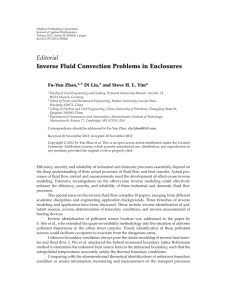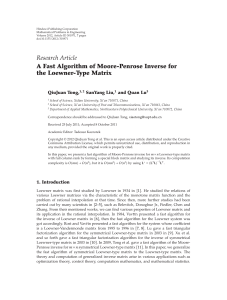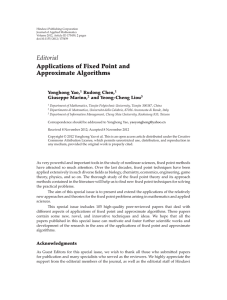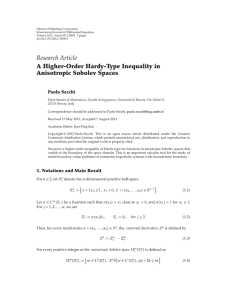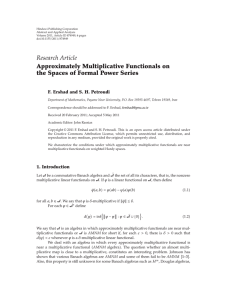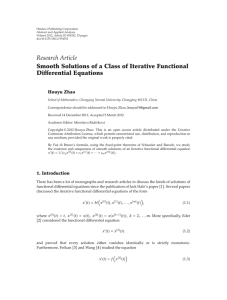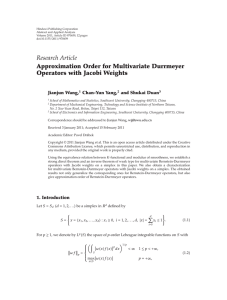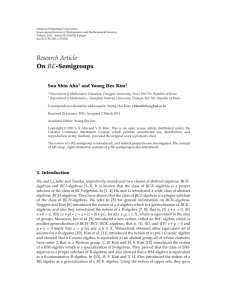Document 10835531
advertisement
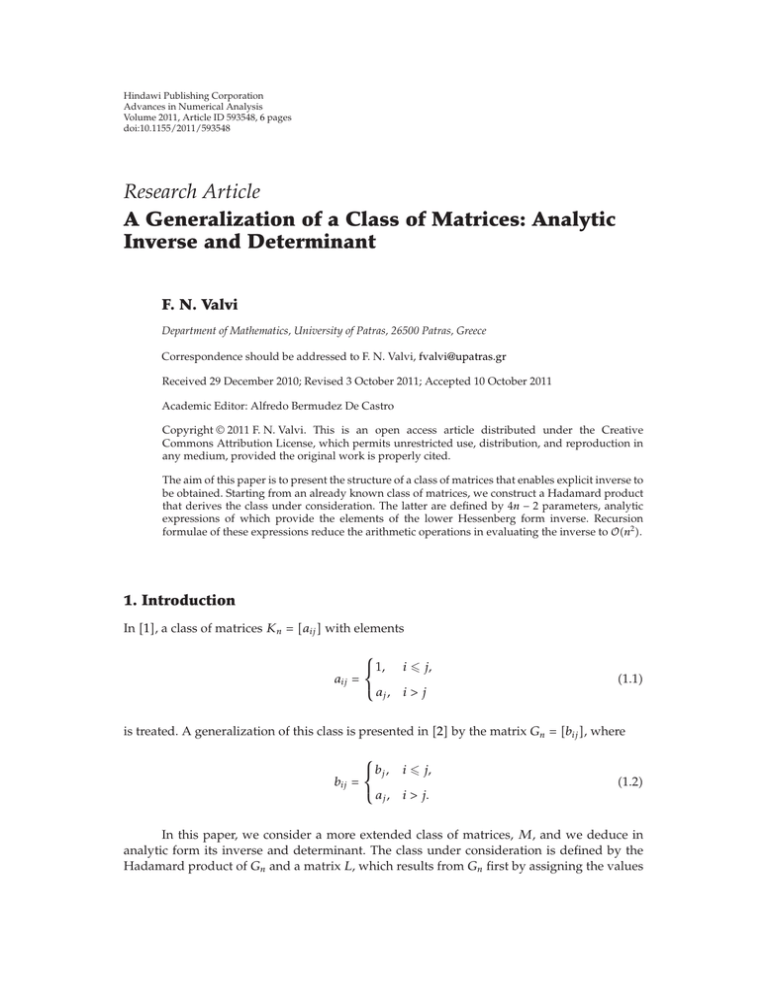
Hindawi Publishing Corporation
Advances in Numerical Analysis
Volume 2011, Article ID 593548, 6 pages
doi:10.1155/2011/593548
Research Article
A Generalization of a Class of Matrices: Analytic
Inverse and Determinant
F. N. Valvi
Department of Mathematics, University of Patras, 26500 Patras, Greece
Correspondence should be addressed to F. N. Valvi, fvalvi@upatras.gr
Received 29 December 2010; Revised 3 October 2011; Accepted 10 October 2011
Academic Editor: Alfredo Bermudez De Castro
Copyright q 2011 F. N. Valvi. This is an open access article distributed under the Creative
Commons Attribution License, which permits unrestricted use, distribution, and reproduction in
any medium, provided the original work is properly cited.
The aim of this paper is to present the structure of a class of matrices that enables explicit inverse to
be obtained. Starting from an already known class of matrices, we construct a Hadamard product
that derives the class under consideration. The latter are defined by 4n − 2 parameters, analytic
expressions of which provide the elements of the lower Hessenberg form inverse. Recursion
formulae of these expressions reduce the arithmetic operations in evaluating the inverse to On2 .
1. Introduction
In 1, a class of matrices Kn aij with elements
aij ⎧
⎨1,
i j,
⎩a , i > j
j
1.1
is treated. A generalization of this class is presented in 2 by the matrix Gn bij , where
bij ⎧
⎨bj ,
i j,
⎩a ,
j
i > j.
1.2
In this paper, we consider a more extended class of matrices, M, and we deduce in
analytic form its inverse and determinant. The class under consideration is defined by the
Hadamard product of Gn and a matrix L, which results from Gn first by assigning the values
2
Advances in Numerical Analysis
ai ln−i1 and bi kn−i1 to the latter in order to get a matrix K, say, and then by the relation
L P K T P , where P pij is the permutation matrix with elements
pij ⎧
⎨1,
i n − j 1,
⎩0,
otherwise.
1.3
The so-constructed class is defined by 4n − 2 parameters, and its inverse has a lower
Hessenberg analytic expression. By assigning particular values to these parameters, a great
variety of test matrices occur.
It is worth noting that the classes L and Gn that produce the class M L ◦ Gn belong to
the extended DIM classes presented in 3 as well as to the categories of the upper and lower
Brownian matrices, respectively, as they have been defined in 4.
2. The Class of Matrices and Its Inverse
Let M mij be the matrix with elements
mij ⎧
⎨ki bj ,
i j,
⎩l a ,
i j
i > j,
2.1
that is,
⎡
k1 b1
k1 b2
k1 b3
···
k1 bn−1
k1 bn
⎤
⎢
⎥
⎢ l2 a1 k2 b2 k2 b3 · · · k2 bn−1 k2 bn ⎥
⎢
⎥
⎢
⎥
⎢ l3 a1 l3 a2
k3 b3 · · · k3 bn−1 k3 bn ⎥
⎢
⎥
M⎢
⎥.
⎢ ···
⎥
⎢
⎥
⎢
⎥
⎢ln−1 a1 ln−1 a2 ln−1 a3 · · · kn−1 bn−1 kn−1 bn ⎥
⎣
⎦
ln a1
ln a2
ln a3
···
ln an−1
2.2
kn bn
If M−1 μij is its inverse, then the following expressions give its elements
⎧
ki1 bi−1 − li1 ai−1
⎪
⎪
,
⎪
⎪
ci−1 ci
⎪
⎪
⎪
⎪
k2
⎪
⎪
,
⎪
⎪
⎪ c0 c1
⎪
⎪
⎪
⎪
⎪
b
⎪
⎨ n−1 ,
μij cn−1 cn
⎪
⎪
dj−1 gi i−1
⎪
νj1 fν
ij
⎪
⎪
,
−1
⎪
i
⎪
⎪
⎪
νj−1 cν
⎪
⎪
⎪ 1
⎪
⎪
− ,
⎪
⎪
⎪
ci
⎪
⎪
⎩
0,
i j 2, 3, . . . , n − 1,
i j 1,
i j n,
i > j,
i j − 1,
i < j − 1,
2.3
Advances in Numerical Analysis
3
where
ci ki1 bi − li1 ai ,
i 1, 2, . . . , n − 1,
c 0 k1 ,
di ai1 bi − ai bi1 ,
i 1, 2, . . . , n − 2,
d0 a1 ,
fi li ai − ki bi ,
i 2, 3, . . . , n − 1,
gi ki1 li − ki li1 ,
i 2, 3, . . . , n − 1,
cn bn ,
2.4
gn ln ,
with
i−1
fν 1
whenever i j 1,
2.5
νj1
and with the obvious assumption
ci / 0,
i 0, 1, 2, . . . , n.
2.6
3. The Proof
We prove that the expressions 2.3 give the inverse matrix M−1 . To that purpose, we reduce
M to the identity matrix by applying elementary row operations. Then the product of the
corresponding elementary matrices gives the inverse matrix. In particular, adopting the
conventions 2.4, we apply the following sequence of row operations:
Operation 1. row i − ki /ki1 × rowi 1, i 1, 2, . . . , n − 1, which gives the lower triangular
matrix
⎡
k1
c1
k2
a1
g2
k3
···
⎢
⎢
⎢
⎢
⎢
⎢
⎢
⎢
⎢
⎢ a1
⎢ gn−1
⎣ kn
gn a1
0
···
k2
c2 · · ·
k3
···
···
0
0
···
a2
kn−1
gn−1 · · ·
cn−1
kn
kn
gn a2 · · · gn an−1
⎤
0 ⎥
⎥
⎥
0 ⎥
⎥
⎥
.
··· ⎥
⎥
⎥
⎥
0 ⎥
⎦
gn bn
3.1
Operation 2. row i − ki gi /ki1 gi−1 × rowi − 1, i n, n − 1, . . . , 3, kn1 1, which results in a
bidiagonal matrix with main diagonal
kn−1 cn−1
k1 c1 k2 c2
,
,...,
, kn bn
k2
k3
kn
3.2
4
Advances in Numerical Analysis
and lower first diagonal
a1 g2 k3 g3 f2
kn−1 gn−1 fn−2 kn gn fn−1
,
,...,
,
k3
k4 g 2
kn gn−2
gn−1
3.3
.
Operation 3. row 2 − k2 a1 g2 /k1 k3 c1 × row 1, and row i − ki ki gi fi−1 /ki−1 ki1 gi−1 ci−1 × rowi −
1, i 3, 4, . . . , n, which gives the diagonal matrix
k1 c1
k2
k2 c 2
k3
···
kn bn .
kn−1 cn−1
kn
3.4
Operation 4. ki1 /ki ci × row i, i 1, 2, . . . , n, which gives the identity matrix.
Operations 1–4 transform the identity matrix to the following forms, respectively:
Form 1. The upper bidiagonal matrix consisting of the main diagonal
3.5
1, 1, . . . , 1
and the upper first diagonal
−
kn−1
k1 k2
,− , ...,−
.
k2 k3
kn
3.6
Form 2. The tridiagonal matrix
⎡
1
−
k1
k2
0
⎢
⎢
k2
⎢
⎢0
1
−
⎢
k
3
⎢
k3 g3 k3 k4 l2 − k2 l4 ⎢
⎢0 −
⎢
k4 g 2
k4 g 2
⎢
⎢· · ·
⎢
⎢
⎢
⎢0
0
0
⎢
⎢
⎢
⎢0
0
0
⎣
···
···
···
···
···
⎤
0
0
⎥
⎥
⎥
0
0 ⎥
⎥
⎥
⎥
0
0 ⎥
⎥
⎥
⎥.
⎥
⎥
kn−1 kn ln−2 − kn−2 ln kn−1 ⎥
⎥
−
kn gn−2
kn ⎥
⎥
kn gn
kn ln−1 ⎥
⎥
−
gn−1
gn−1 ⎦
3.7
Advances in Numerical Analysis
5
Form 3. The lower Hessenberg matrix
⎡
−
1
⎤
k1
k2
⎢
⎢
⎢
a1 g2 k2
k2
⎢
−
k3 b1 − l3 a1 ⎢
k1 k3 c 1
k3 c 1
⎢
⎢
⎢
a1 g3 k3 f2
d1 g 3 k 3
⎢
−
⎢
k1 k4 c 1 c 2
k4 c 1 c 2
⎢
⎢
···
⎢
⎢
⎢ a1 gn−1 kn−1 f2 · · · fn−2 d1 gn−1 kn−1 f3 · · · fn−2
⎢s
s
⎢
k1 kn c1 · · · cn−2
kn c1 c2 · · · cn−2
⎢
⎢
⎣ a1 gn kn f2 · · · fn−1
d1 gn kn f3 · · · fn−1
s
s
k1 c1 · · · cn−1
c1 c2 · · · cn−1
···
···
···
···
···
0
0
⎥
⎥
⎥
0
0 ⎥
⎥
⎥
⎥
⎥
0
0 ⎥
⎥
⎥, 3.8
⎥
⎥
⎥
kn−1
kn−1 ⎥
⎥
kn bn−2 − ln an−2 −
kn cn−2
kn ⎥
⎥
⎥
dn−2 gn kn
bn−1 kn ⎦
−
cn−2 cn−1
cn−1
where the symbol s stands for the quantity −1ij .
Form 4. The matrix whose elements are given by the expressions 2.4.
The determinant of M takes the form
detM k1 bn k2 b1 − l2 a1 · · · kn bn−1 − ln an−1 .
3.9
Evidently, M is singular if ci 0 for some i ∈ {0, 1, 2, . . . , n}.
4. Numerical Complexity
The inverse of the matrix M is given explicitly by the expressions 2.3. However, a careful
reader could easily derive the recursive algorithm that gives the elements under the main
diagonal of M−1 . In particular,
μi,i−1 −
μi,i−s−1
di−2 gi
,
ci−2 ci−1 ci
di−s−2 fi−s
−
μi,i−s ,
di−s−1 ci−s−2
i 2, 3, . . . , n,
4.1
i 3, 4, . . . , n, s 1, 2, . . . , i − 2,
or, alternatively,
μj1,j −
μjs1,j
dj−1 gj1
,
cj−1 cj cj1
gjs1 fjs
−
μjs,j ,
gjs cjs1
j 1, 2, . . . , n − 1,
4.2
j 1, 2, . . . , n − 2, s 1, 2, . . . , n − j − 1,
where the ci , di , fi , and gi are given by the relations 2.4. By use of the above algorithms,
the estimation of the whole inverse of the matrix M is carried out in 2n2 11n − 19
6
Advances in Numerical Analysis
multiplications/divisions, since the coefficient of μij depends only on the second first
subscript, respectively, and in 5n − 9 additions/subtractions.
5. Remarks
When replacing ki , bi , and ai by ai , ki , and bi , respectively, the matrix M see 2.2 is
transformed into the transpose CT of the matrix C 5, Section 2. However, the primary fact for
a test matrix is the structure of its particular pattern, which succeeds in yielding the analytic
expression of its inverse. In the present case, the determinants of the minors of the elements
mij , i > j 1, vanish to provide the lower Hessenberg type inverse. In detail, each minor of
M, that occurs after having removed the ith row and jth column, i > j 1, has the determinant
of its i − 1 × i − 1 upper left minor equal to zero, since the last two columns of the latter are
linearly dependent. Accordingly, by using induction, it can be proved that all the remaining
upper left minors of order i, i 1, . . . , n − 1 vanish.
References
1 H. W. Milnes, “A note concerning the properties of a certain class of test matrices,” Mathematics of
Computation, vol. 22, pp. 827–832, 1968.
2 R. J. Herbold, “A generalization of a class of test matrices,” Mathematics of Computation, vol. 23, pp.
823–826, 1969.
3 G. Carayannis, N. Kalouptsidis, and D. G. Manolakis, “Fast recursive algorithms for a class of linear
equations,” IEEE Transactions on Acoustics, Speech, and Signal Processing, vol. 30, no. 2, pp. 227–239, 1982.
4 M. J. C. Gover and S. Barnett, “Brownian matrices: properties and extensions,” International Journal of
Systems Science, vol. 17, no. 2, pp. 381–386, 1986.
5 F. N. Valvi, “Analytic inversion for a general case of certain classes of matrices,” International Journal of
Computer Mathematics, vol. 72, no. 2, pp. 199–205, 1999.
Advances in
Operations Research
Hindawi Publishing Corporation
http://www.hindawi.com
Volume 2014
Advances in
Decision Sciences
Hindawi Publishing Corporation
http://www.hindawi.com
Volume 2014
Mathematical Problems
in Engineering
Hindawi Publishing Corporation
http://www.hindawi.com
Volume 2014
Journal of
Algebra
Hindawi Publishing Corporation
http://www.hindawi.com
Probability and Statistics
Volume 2014
The Scientific
World Journal
Hindawi Publishing Corporation
http://www.hindawi.com
Hindawi Publishing Corporation
http://www.hindawi.com
Volume 2014
International Journal of
Differential Equations
Hindawi Publishing Corporation
http://www.hindawi.com
Volume 2014
Volume 2014
Submit your manuscripts at
http://www.hindawi.com
International Journal of
Advances in
Combinatorics
Hindawi Publishing Corporation
http://www.hindawi.com
Mathematical Physics
Hindawi Publishing Corporation
http://www.hindawi.com
Volume 2014
Journal of
Complex Analysis
Hindawi Publishing Corporation
http://www.hindawi.com
Volume 2014
International
Journal of
Mathematics and
Mathematical
Sciences
Journal of
Hindawi Publishing Corporation
http://www.hindawi.com
Stochastic Analysis
Abstract and
Applied Analysis
Hindawi Publishing Corporation
http://www.hindawi.com
Hindawi Publishing Corporation
http://www.hindawi.com
International Journal of
Mathematics
Volume 2014
Volume 2014
Discrete Dynamics in
Nature and Society
Volume 2014
Volume 2014
Journal of
Journal of
Discrete Mathematics
Journal of
Volume 2014
Hindawi Publishing Corporation
http://www.hindawi.com
Applied Mathematics
Journal of
Function Spaces
Hindawi Publishing Corporation
http://www.hindawi.com
Volume 2014
Hindawi Publishing Corporation
http://www.hindawi.com
Volume 2014
Hindawi Publishing Corporation
http://www.hindawi.com
Volume 2014
Optimization
Hindawi Publishing Corporation
http://www.hindawi.com
Volume 2014
Hindawi Publishing Corporation
http://www.hindawi.com
Volume 2014
